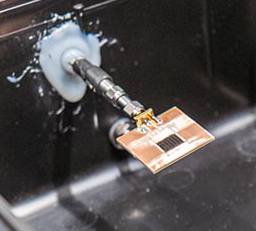An artificial nose with a single sensor can distinguish six volatile organic compounds 96% of the time and differentiate grapes bought yesterday from those bought last week.

Researchers from the Norwegian University of Science and Technology in Gjøvik have developed a small antenna partially coated with graphene oxide and the ionic polymer Nafion. This general-purpose coating, made from a straightforward blend of commercial graphene particles and Nafion, is applied using a solvent that evaporates to leave a durable layer.
The antenna, manufactured on a 33 x 33mm substrate, features a microstrip design capable of operating across a frequency range of 1 to 8GHz. Sensing occurs as the antenna is driven by a signal sweeping across this bandwidth, with reflections recorded by a network analyzer. This variable-frequency approach enhances smell-sensing capabilities, bypassing the need for numerous transducers, each tuned to a different chemical.
Analysis of these reflections’ real and imaginary components has enabled the creation of detection fingerprints. These have consistently identified four different alcohols—methyl, ethyl, propyl, and butyl—. When two isomers, 2-butyl alcohol and isopropyl alcohol, were added, differentiation slightly declined but remained high at 96.7%.
In practical tests, the technology could distinguish between bruised apples with intact skin and unblemished ones, strawberries purchased one day prior from those bought five days earlier, and, similarly, grapes. During these tests, the antenna was placed inside a 10-litre container, and samples were left for several minutes to allow emitted chemicals to be detected.
Experiments with a similar antenna coated with graphite instead of graphene also yielded positive results, albeit with significantly lower sensitivity. Simultaneously, this antenna could transfer data over the 5.8GHz ISM band, showcasing its dual functionality.
The team says that the technology surrounding us, which utilizes antennas for communication, can be adapted to incorporate sensor functions, allowing existing infrastructure to be repurposed for new applications. They also foresee potential medical applications. Similar to how trained dogs can detect changes in blood sugar and diseases like cancer through volatile organic compounds, the principle behind the antenna sensor functions operates on largely the same basis.












